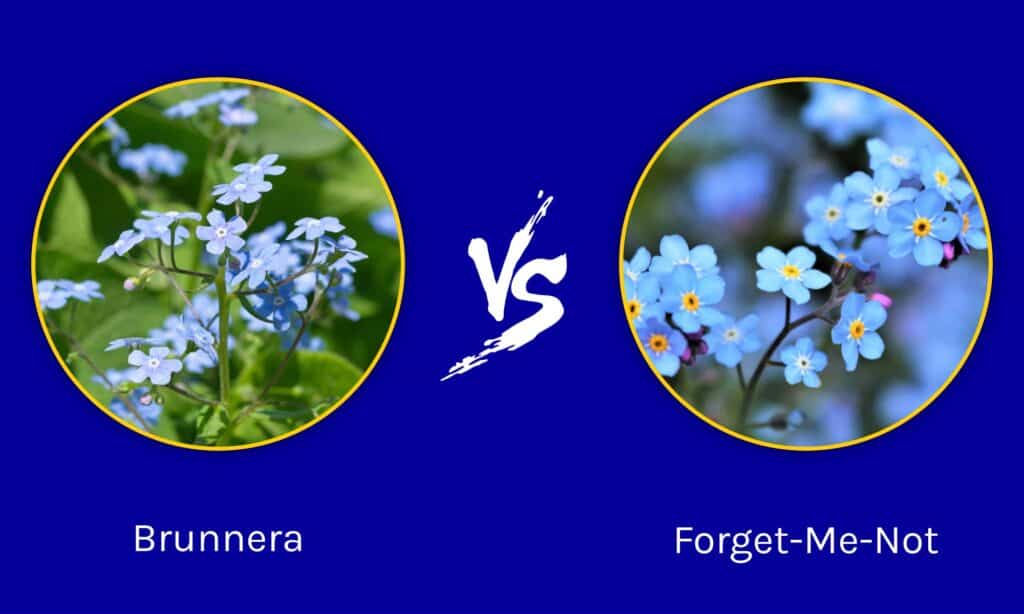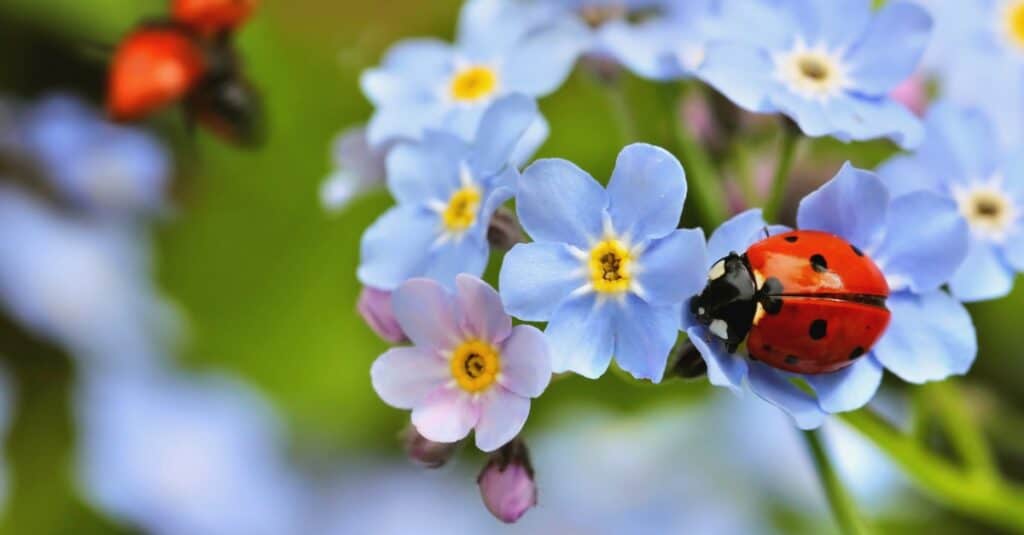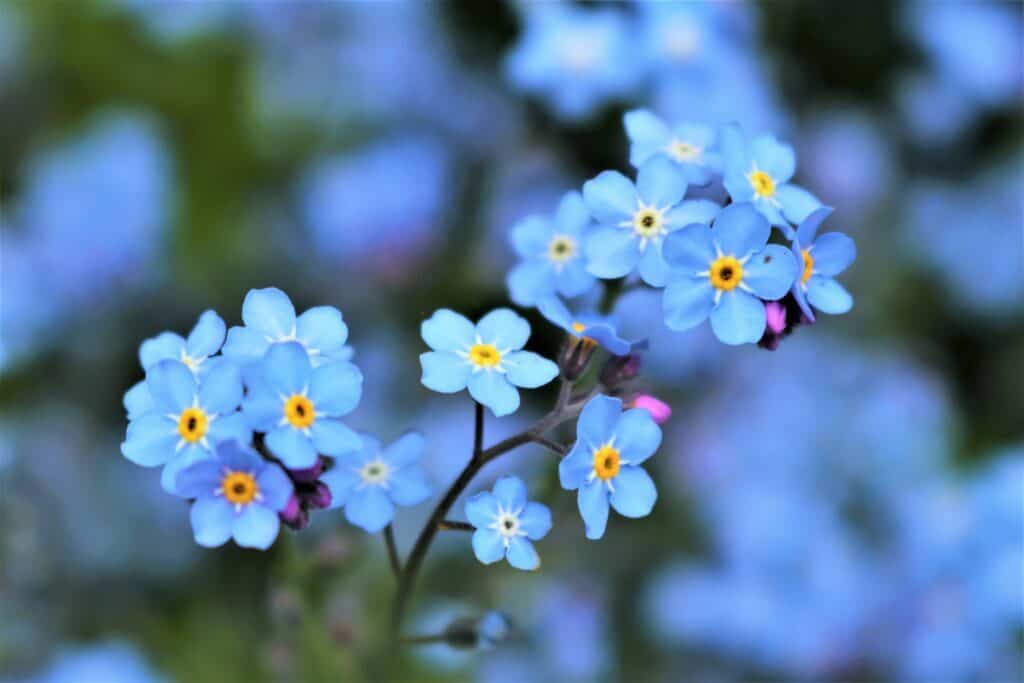Forget-me-nots (Myosotis scorpioides) are a beloved flower. They also have a long, storied history. But, as unique as they seem, there is another very similar plant. Brunnera (Brunnera macrophylla) is sometimes referred to as the “false forget-me-not” due to its striking similarities to true forget-me-nots. When the flowers bloom in the height of spring, it can be difficult to tell them apart.
However, there are some differences between the two. Once you learn how to distinguish brunnera from forget-me-nots, it will be easy to tell them apart in the future. Below, we explore each plant individually and also compare them side by side. You will learn the unique attributes, identifying features, and growing notes if you want to add them to your outdoor space or garden.

Brunnera vs. Forget-me-not: A Comparison
| Brunnera | Forget-Me-Not | |
|---|---|---|
| Scientific Classification | Brunnera macrophylla (this is a classification change from Anchusa myosotidiflora) | Myosotis scorpioides; Myosotis palustris |
| Common/Alternate Name(s) | Brunnera; False forget-me-not; Large-leaf brunnera; Siberian bugloss | Yelloweye forget-me-not; Forget-me-not; Scorpion Weed, Love-me, Marsh Scorpion Grass |
| Origin | Eastern Europe and Siberia | Europe and Asia |
| Size | A round bush that can reach 1.5’ tall and up to 2.5’ wide. If left unattended, it develops rhizomes that branch out and create a beautiful ground cover. | Grows to a height of 4-24”. It can reach roughly 12” wide. |
| Flower | Delicate blue sprays of flowers with a yellow center and 5 petals. | Blue flowers with 5 petals and a yellow center. |
| Leaves | Heart-shaped leaves that have tiny hairs on them. The leaves are a deep green, with a glossy coating of white, gray, or silver on top. | Long and oblong leaves that taper toward the stem. They are widest in the middle and rounded at the end. |
| Habitat | Shaded areas with moist, rich, and well-draining soil. They do not like heat. | These plants love a wet habitat. They are particularly fond of pond margins, wet meadows, swamps, and ditches. |
| Growing Requirements | Perennial. Prefers rich, well-draining soil but will also happily grow in clay-based soils. Grows best in Zones 3-8. Loves partial shade. Low maintenance, Deer and rabbit resistant. Relatively pest free. | Perennial. Blooms arrive between May to September. Thrives in wet soil. Primarily found in Zones 5-9. Partial shade and wet soil. |
| Fun Facts | Nicknamed ‘Jack Frost’ or false forget-me-nots. | First described in literature in 1532. Features a prominent role in European folklore. |
The Key Differences Between Brunnera and Forget-me-not
The brief overview above provides a quick glance into the unique attributes of each plant. However, to gather a complete picture, it is important to examine the plants side-by-side in the areas where they differ.
Both plants have delicate, 5-petal blue flowers with a yellow center when they bloom mid-spring. But that is where the similarities end. The primary differences lie in the origin, habitat, leaves, and growing requirements.
Keep reading for a deeper exploration of these two beautiful plants.
1. Brunnera vs. Forget-me-not: Classification
The Boraginaceae (borage) family comprises both Brunnera and forget-me-nots. However, many genera and species varieties fall under the large umbrella of the borage plant family. Brunnera belongs to the Brunnera genus, and forget-me-nots belong to the Myosotis genus.

Forget-me-nots belong to the
Myosotisgenus.
©Marek Mierzejewski/Shutterstock.com
2. Brunnera vs. Forget-me-not: Origins
Brunnera is native to Eastern Europe and Siberia. However, forget-me-nots are originally from Europe and Asia.
3. Brunnera vs. Forget-me-not: Habitat
The preferred habitats of brunnera and forget-me-nots are where it becomes very easy to distinguish between the two plants. Brunnera loves rich, well-draining soil.
In contrast, true forget-me-nots adore watery homes. That is why they are sometimes also referred to as water forget-me-nots. They need a wet environment to survive and can grow in up to 3” of water. They also are considered invasive in some areas due to their propensity to choke out nearby competitors.
Both plants thrive in partially shaded environments and strongly dislike excess heat.
4. Brunnera vs. Forget-me-not: Leaves
The leaves of Brunnera are heart-shaped, have a rough texture, and have some hair. They are dark green with a very distinctive glossy color overlaid on top. It can appear in shades of white, silver, or gray. And the additional frosted coloring does not cover the leaves’ veins, creating a unique pattern.
The leaves of forget-me-nots are long and oblong. They reach their broadest width in the middle, tapering toward the stem, and have a rounded tip. The surface of their leaves also has sparse hairs.

The leaves of brunnera are heart-shaped, have a rough texture, and have some hair.
©iStock.com/koromelena
5. Brunnera vs. Forget-me-not: Growing Requirements
Brunnera is a low-maintenance and beautiful plant. Thanks to the unique coloring of brunnera’s leaves, it has the additional benefit of being an ornamental plant for landscaping and garden areas. It can get added to any space that needs ground cover or simply to break up the monotony of the other green plants.
It requires rich, healthy soil that is kept moist but not soggy. A thick layer of mulch will help reduce the frequency of watering. As long as the soil does not dry out and the plants get provided with adequate shade, brunnera will grow happily year after year.
Forget-me-nots prefer a slightly warmer environment. Since the plant is erect and does not spread as widely as brunnera, you can incorporate them in tighter spaces or between other flowers and plants.
Forget-me-nots need wet soil. So they are the ideal solution for areas along rock walls, creek or pond banks, or other spaces too moist for most plants. They are easy plants to grow, provided they have quality soil, ample water, and at least a little shade.

Forget-me-nots prefer a slightly warmer environment.
©iStock.com/Agnieszka Klimaszewska
The photo featured at the top of this post is © iStock.com/Agnieszka Klimaszewska
Sources
- NC State Extension, Available here: https://plants.ces.ncsu.edu/plants/brunnera-macrophylla/
- The Jepson Herbarium, Available here: https://ucjeps.berkeley.edu/eflora/eflora_display.php?tid=34214
- GLANSIS, Available here: https://nas.er.usgs.gov/queries/greatlakes/FactSheet.aspx?Species_ID=2686&Potential=N&Type=0
- MISIN, Available here: http://www.misin.msu.edu/facts/detail/?project=misin&id=144&cname=True+forget-me-not
FAQs (Frequently Asked Questions)
Do brunnera and forget-me-nots die in the winter?
Both brunnera (Brunnera macrophylla) and forget-me-nots (Myosotis scorpioides) are herbaceous perennial plants. So, they die back in the winter and grow back once the weather warms up again.
Do brunnera and forget-me-nots require a lot of sun?
Both plants prefer areas that provide partial shade. They can tolerate a little sun and heat as long as they receive shade during the hottest parts of the day.
Where can I grow brunnera and forget-me-nots?
Brunnera (Brunnera macrophylla) thrives in USDA Hardiness Zones 3-8 and can handle slightly more heat than other brunnera species. But forget-me-nots (Myosotis scorpioides) need a little extra warmth. They grow best in USDA Hardiness Zones 5-9. Plant them in areas other plants don’t like due to the lack of drainage.
Are brunnera and forget-me-nots fast growers?
Brunnera (Brunnera macrophylla) is a relatively slow-growing plant. So you can incorporate it into your space without worrying about it taking over or becoming too invasive. In contrast, forget-me-nots (Myosotis scorpioides) grow and spread rapidly. They are considered invasive in many areas, so if you plant them in your garden or yard, you will need to prune or cut them back often.
Thank you for reading! Have some feedback for us? Contact the AZ Animals editorial team.






